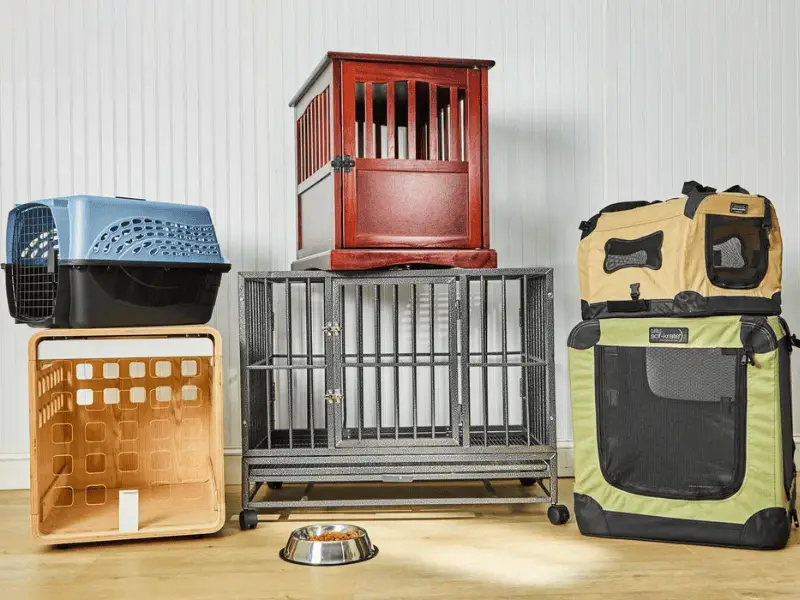Discover the truth about breeding dogs of different sizes. It is always preferable to get a dog from a shelter, and you still need to explore the risks and factors to consider when searching for a dog.

What do you know about breeding dogs of different sizes?
When it comes to choosing a new member of your fur family, many people start by looking at different breeds. Some people prefer their dogs to be purebred, while others believe mixed breeds are just as charming and lovable.
The idea of breeding dogs has been around for centuries, and it was initially done to produce specific traits like hunting or herding abilities. However, in recent times, the concept of mixing breeds has become popular among dog owners who want unique pets. But, what are the concerns about breeding dogs of different sizes?
The common notion is that any two dog breeds can be mixed regardless of their size difference. However, this raises an important question: is it really possible to mix any two dog breeds without considering the size difference?
Let’s explore the world of dog breeding and help you understand whether it’s safe to mix different sized dogs or not. So, come join us on this journey as we discover what goes into making our furry four-legged friends!
Understanding Dog Breeding:
Breeding dogs involves the intentional reproduction of two purebred dogs in order to produce puppies with specific desirable traits.
Breeding aims to create a better quality of dog that can excel in certain roles such as hunting, herding, or companionship. Purebred dogs have been selectively bred for generations to conform to a specific breed standard.
These standards are set by various organizations, such as the American Kennel Club (AKC), and outline the physical and behavioral characteristics that define each breed. Purebred dogs have predictable temperaments and physical traits, making them ideal for certain tasks and lifestyles.
Crossbreeding is the practice of breeding two different purebred dogs to produce a hybrid or mixed-breed puppy. There are advantages and disadvantages to crossbreeding.
One advantage is that crossbreeds tend to be healthier than purebreds because they have a more diverse genetic makeup. However, there is no guarantee which traits will be passed down from each parent dog, making it difficult to predict temperament or physical appearance.
Overall, breeding dogs requires knowledge and responsibility. Breeders must prioritize their animals’ health and well-being above all else while also striving towards producing exceptional puppies with desirable qualities.
Breeding Dogs of Different Sizes: The Importance of Size in Dog Breeding
When it comes to dog breeding, size does matter. It’s important to consider the size of the two breeds being mixed because it can affect breeding compatibility.
Breeders need to ensure that the male and female dogs are of a similar size so that they can mate safely and without complications.
Dogs that are too big or too small for each other can have difficulties during mating, which can result in injury or even death. Furthermore, the size difference between two dogs can also affect the growth and development of puppies.
If a large dog breeds with a small one, it’s possible that their offspring will inherit genes from both parents but end up being too big or too small for their breed standard.
This has serious implications for their health and wellbeing as they grow up, particularly if they end up with health issues like joint problems or heart disease.
The risks involved when mixing dogs with significant size differences
Breeding dogs with significant size differences is not recommended due to the risks involved. For example, if a large dog breeds with a smaller one, there is a risk that the smaller dog could be injured during mating or pregnancy/birth complications could occur because their bodies are not compatible in terms of size.

Additionally, if puppies inherit genes from both parents but end up being too small for their breed standard, they may suffer from various health issues such as breathing difficulties or skeletal deformities.
It’s important to note that while there are certainly risks involved when mixing different sized dogs, there are also breeding techniques available to help mitigate those risks.
One common technique is artificially inseminating a female dog with semen collected from a male dog larger than her breed standard to avoid any harm during natural mating.
Nevertheless, caution should still be taken by breeders when attempting to mix different sized dogs – after all, safety should always come first when it comes to breeding animals.
Factors to Consider When Mixing Dog Breeds
Temperament and Personality Traits
When it comes to mixing dog breeds, it’s important to consider the personality traits of both breeds. Some breeds are more dominant, while others are more submissive.
There are also breeds that may have a high prey drive, making them dangerous to smaller animals or even children. Researching and considering these traits before deciding on a breed mix is important.
This will help ensure that both dogs will get along well and create a harmonious household. Another factor to consider is the compatibility between the temperaments of the two dogs.
A good match is one where the personalities complement each other rather than clash. For example, if one dog is very high-energy and playful, it might be best not to mix them with an older dog who prefers quieter activities.
Health Concerns
Another factor that should be taken into consideration when mixing different sized breeds is health concerns. While there are no guarantees when it comes to breeding healthy puppies, certain health issues can arise from breeding two dogs of vastly different sizes.
For example, if you mix a large breed with a small one, there is an increased risk of hip dysplasia in the puppies because they might inherit genes for both large and small hips from their parents.
Additionally, smaller dogs may struggle with birthing larger puppies which can lead to complications during pregnancy or birth. Before deciding on a breed mix, it’s important to research each breed’s common health issues so you can determine if your potential mixed-breed puppy would be at risk for any of these issues.
Exercise Needs

Exercise needs should also be considered when mixing different sized dog breeds. While some breeds thrive on long walks or hikes in the mountains, others prefer short walks around the block or indoor playtime on a rainy day.
When considering mixing breeds, it’s crucial to understand the exercise needs of both breeds and find a happy medium.
For example, if you’re thinking about mixing a high-energy breed like the Border Collie with a smaller, less active dog like a Chihuahua, you’ll need to make sure that both dogs are getting enough exercise. This could mean taking shorter walks more often or finding other fun activities that both dogs will enjoy.
Ultimately, careful consideration of these factors is needed when choosing to mix any two dog breeds no matter the size difference.
By researching and understanding these various factors you can help ensure that your new mixed-breed puppy will be happy and healthy for years to come.
Examples of Successful Breed Mixes with Size Differences
Poodle mixes (e.g., Labradoodle, Goldendoodle)
One of the most popular breed mixes when it comes to size differences is the poodle mix. This is because poodles themselves come in different sizes, so they can easily be bred with other breeds regardless of size.
The Labradoodle, for instance, is a mix between a Labrador Retriever and a Poodle. They can grow anywhere from 22 to 24 inches tall and weigh between 50 to 90 pounds depending on their size variation.
Goldendoodles are another popular breed mix that are known for their friendly temperament and hypoallergenic coat. These adorable dogs are a cross between Golden Retrievers and Poodles and can range in size from medium to large.
Poodles have desirable traits such as being hypoallergenic, intelligent, and highly trainable. When mixed with other breeds that may not have these qualities, it can create puppies with the best of both breeds.
Corgi mixes (e.g., Corgipoo, Corgidor)
Corgis are small but mighty dogs that make great family pets due to their loyal nature and affectionate personalities. When mixed with other breeds such as Poodles or Labrador Retrievers, they create adorable hybrids like the Corgipoo or the Corgidor.
The Corgipoo is a crossbreed between a Pembroke Welsh Corgi and a Toy Poodle or Miniature Poodle. Depending on their parent’s size variation, they tend to weigh anywhere from 12-30 pounds.
The Corgidor is an adorable hybrid of a Labrador Retriever and Welsh Corgi that loves spending time outdoors due to its energetic nature. The benefit of breeding these mixtures is creating puppies with desirable physical features like longer or curl coats or unique color patterns.
Bulldog mixes (e.g., Bullmastiff, Boxer)
Bulldogs are adorably wrinkled and lovable dogs known for their loyalty and protectiveness. When bred with other breeds like the Bullmastiff or Boxer, they can create dogs with unique aesthetics and traits. For instance, the Bullmastiff Bulldog mix is a cross between a Bulldog and a Bullmastiff.
They tend to have short coats that come in different shades of brown or black. These dogs are loyal and protective, making them great family pets.
The Boxer Bulldog mix is another popular breed mix that combines the affectionate nature of Bulldogs with the energetic spirit of Boxers. These dogs can grow up to 25 inches tall and weigh anywhere from 45 to 80 pounds, depending on their size variation.
However, it’s important to note that breeding two vastly different sizes may lead to complications during pregnancy/birth that could be life-threatening for both the mother dog and her puppies. It’s crucial to consult a vet before proceeding with any breeding plans.
Risks Involved in Mixing Different Sized Dogs
Physical Risks: Injury or Death During Mating or Pregnancy/Birth Complications
Although the idea of mixing two different dog breeds can seem great in theory, it’s important to understand that there are significant risks involved when the size difference between the two breeds is significant.

One of the most significant physical risks is injury or even death during mating.
When a larger dog mates with a smaller one, there is a high risk of injury to the smaller dog, which can lead to severe injuries and even death. Pregnancy and birth complications are also common when breeding dogs with significant size differences.
Smaller dogs may struggle to carry and give birth to large puppies, leading to complications such as uterine infections or even death.
Additionally, if a large dog mates with a small one, their offspring may be too big for the smaller dog‘s pelvis during delivery, which can cause serious problems.
Mental Risks: Aggression or Anxiety
While physical risks are certainly concerning when breeding dogs of different sizes, mental risks such as aggression or anxiety are also important considerations.
Dogs have different temperaments and personalities that may not always mix well together when bred. Large dogs may be more aggressive towards smaller ones due to their size advantage and dominance mentality.
Additionally, small dogs bred with large ones may experience anxiety due to feeling overwhelmed by their larger counterparts. This can result in behavioral issues such as excessive barking and biting.
It’s essential always to consider physical and psychological compatibility before choosing which breeds you want to breed together based on their looks alone.
While it may seem like a fun idea on paper, mixing two breeds of significantly different sizes can come with many potential risks for both the parent dogs and their offspring.
It’s important to always consider physical and psychological factors before breeding two different breeds together.
A responsible breeder should always prioritize the health and well-being of their dogs and put priority on creating happy, healthy litters rather than just breeding for aesthetics or popularity.
Final Thoughts About Breeding Dogs of Different Sizes
Throughout this article, we have explored the idea of mixing different dog breeds, regardless of their size differences. We started by understanding the basics of dog breeding and the purpose behind it.

We then delved into the significance of size in breeding compatibility, emphasizing how it affects the risks involved in the process. Furthermore, we discussed various factors to consider when mixing different dog breeds, such as temperament, health concerns, and exercise needs.
We also highlighted examples of successful breed mixes with significant size differences, like poodle mixes, such as Labradoodles and Goldendoodles; Corgi mixes, including Corgipoos and Corgidors; and Bulldog mixes, like Bullmastiffs and Boxers.
These breed mixes have proven highly successful due to their compatible temperaments and manageable size differences.
However, we must also acknowledge that there are risks involved in mixing different-sized dogs together. Physical risks include injury or death during mating or pregnancy/birth complications, while mental risks may manifest as aggression or anxiety.
Nevertheless, these risks can be minimized through proper research on compatible breeds. While mixing any two dog breeds, regardless of their size difference, is possible, it is important to consider various factors before doing so.
Compatibility between the dogs’ temperaments and health concerns should always be prioritized over appearance alone. By doing so, you can ensure a successful breed mix that will bless your home with an amazing family pet for many years to come!


